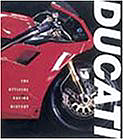|
Nicki
Lane
in Member's Corner! She's our official SBK Fast Dates World Superbike trophy girl, official Ducati Corse umbrella girl for World Champion Troy Bayliss, and Miss Great Britain makes her American debut in the 2004 Fast Dates Racebike, Iron & Lace Custom Bike, and Garage Girls Calendars now available here on our website. SUPERBIKE & GP Calendars! Click on Nicki's cover  RACING
BOOKS! The new CORRS! -In Blue All
the hottest new motorcycle books, Ducati's 2003 Effort in World Superbike 11 Manufacturers' and 9 Ridersí titles are Ducatiís enviable record in the world's top category for production-based racing bikes, and this means that the new Ducati Fila team will surely be a chief candidate for honours in the 2003 championship. Being able to count on the undisputed talent of riders such as Neil Hodgson and Ruben Xaus helped to speed up the development of the new bike, which showed during early winter testing that it would become a worthy heir to the 998, a bike that has reached technical maturity on nearly all circuits. 2003 will again see Ducati accompanied in their challenge by Shell Advance and Michelin, and both companies are sure to make a vital contribution to the final result. But 2003 will also be the year in which the Superbike technical regulations undergo a considerable change for the first time since the start of the championship. It will in fact be possible for twin and four-cylinder machines to compete with the same engine capacity (1000cc). Some manufacturers have already taken advantage of these changes and will take part in the 2003 championship with new models, while others are preparing for entry in 2004. Ducati continues to believe in the potential of the twin-cylinder engine, which they consider to be the best possible solution for an equilibrium between power and ëdriveabilityí for road use, and therefore we will strive to maintain the new 999 Testastretta competitive even after the arrival of the new 1000 cc four-cylinder bikes.
|









